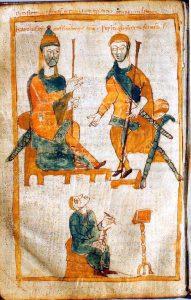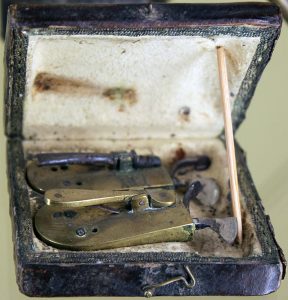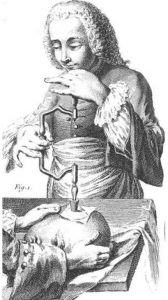Welcome to The History of Barbering, vol. 2!
If you haven’t read volume 1, click here! In this mini-series we’re going to get you guys clued up on your professional pedigree, introducing you to the pretty brutal history in a light and relaxed manner.

Charlemagne sits, left, with Pippin of Italy, who apparently has snake eyes. No idea who the chap chilling below is
In volume 1 we covered the early history of barbering: early man, Ancient Egypt, Greece and Rome. In volume 2 we’re bringing it up to the shining future of A.D. All the way up to 1163, so with over 1000 years of barbering we better cut right to the chase.
In the first few centuries of the A.D. calendar, or ‘Christian Era’ as it is colloquially known, the barbers of Europe really expanded their grooming ground, practicing their profession wherever it was needed. One of the earliest and most famous conquering emperors is Charlemagne, who made long flowing hair the fashion. But each new conqueror changed the fashion to their personal needs and, really, what tickled their fancy. Fortunately we now have the choice ourselves to style our hair however we like, and with proper tools, like the DS+, anything is possible!
The first ten centuries after the death of Christ weren’t exactly the best, we don’t call them the dark ages for nothing, the vast majority of people (even nobles) were uneducated and illiterate. Pretty much the only people who could be considered learned were the monks and priests who became the physicians. There were no professional surgeons at that time. Most of the diseases which are easily curable now, were fatal. Get a splinter? Yeah, you’re dying of sepsis, here let me take your blood for you. Not a great time to be around by all accounts. Especially as bloodletting was the popular cure-all.
Do you think they used a Shaving Bowl to catch the blood?
The clergy enlisted barbers as their assistants, who were among the first to perform bloodletting, which is basically a step in the direction to what we know them as today… so, thanks for bleeding people out I guess? Barbers continued to act as assistants to the physician-clergy until the 12th century, when everything started to change, at the council of Tours (1163). The clergy were forbidden to draw blood or act as physicians/surgeons on the idea that it was sacrilegious for ministers to draw blood from the human body. Father Thomas in Berkshire is no doubt pretty thankful for this. This vital role left a gaping void in society, who could you turn to for your stubbed toe? Barbers stepped up to the plate and took up the duties, and the prosperous era of the barber-surgeon began. This connection lasted for more than 6 centuries. And the entire time this was going on, they were still cutting hair, styling, and shaving beards and moustaches, and if Dark Stag had been around you can guarantee they would be using our Shaving Brush and DS1 Scissor!
In terms of barber organisations, the earliest known was formed in 1096 in France when William, archbishop of Rouen, prohibited the wearing of a beard. Barber-surgeons, or chirurgeons, flourished across Europe. The roles barbers played grew and grew after this, soon encompassing doctoring (as we know) and dentistry. Both of these caused some pretty big squabbles between the barber organisation and doctors and dentists (who thought they were treading on their turf). These arguments got so bad, kings and councils ended up getting involved to resolve them! But barbers retained the privilege of practicing dentistry and surgery for several centuries.
And we will leave it there for now! That’s the first 1000~ years AD of barber history all wrapped up in one neat little article!
Until next time
Dark Stag Team
All images displayed in this article are used from wikimedia commons.







